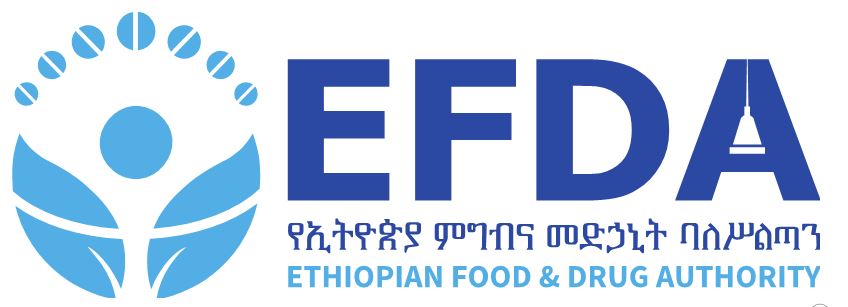GS1-128 is a linear barcode used to encode data for logistics units such as cases and pallets. The use of this barcode supports fast and accurate data capture and inventory tracking, adding visibility to your supply chain. GS1-128 barcodes are commonly used to label a logistic unit with a Serial Shipping Container Code (SSCC).
For more information on GS1 Standards
Contact us
Tel: +251 5524122
Ex- 156
Email: efdatraceability@gmail.com.
GS1 DataMatrix is a two-dimensional (2D) barcode which may be printed as a square or rectangular symbol made up of individual squares. This representation is an ordered grid of dark and light squares bordered by a finder pattern. The finder pattern is partly used to specify the orientation and structure of the symbol. The data is encoded using a series of dark or light squares based upon a pre-determined size. The size of these squares is known as the X-dimension.
A GLN is a string of 13 digits that is globally unique. A GLN is generated by combining the following three components in left-to-right order:
-
GS1 Company Prefix: A globally unique number assigned to a company/organization by GS1 US to serve as the foundation for generating GS1 identifiers including GLNs. (See Section 2.4.) The GS1 Company Prefix is between 6 and 11 digits; the shorter the GS1 Company Prefix, the longer the location reference (below) and therefore the greater number of GLNs that may be allocated.
-
Location< Reference: A number assigned by the holder of the GS1 Company Prefix to uniquely identify a legal entity, functional entity, or physical location. This segment is the “serial” part that is assigned one-by-one by the company to create a globally unique GLN for each entity or location. The number of digits in the Location Reference varies in length depending on the length of the GS1 Company Prefix, so that the total number of digits in the GLN is 13.
-
Check Digit: A single digit computed from the previous 12 digits according to the GS1 check digit calculator.
The GLN for a legal entity is assigned by GS1 and its member organization when the legal entity first registers for a GS1 Company Prefix. For other GLNs, such as functional entities within the legal entity or physical locations, the company that owns the functional entity or that owns or occupies the physical location generates the GLN.
A “corporate GLN” is the GLN that refers to your company as a legal entity. You can use it in any context where you need to identify your company as a legal entity.
Yes. You need a new GTIN to identify a case containing a different number of trade items or to identify a pre-defined pallet configuration containing a different quantity of cases.
The Global Trade Item Number (GTIN) is the globally unique GS1 identification number used to identify “trade items” (i.e., products and services that may be priced, ordered or invoiced at any point in the supply chain). GTINs are assigned by the brand owner of the product, and are used to identify products as they move through the global supply chain to the hospital or consumer/patient. The GTIN is used to uniquely identify a product at each packaging level (e.g., a bottle of 30 tablets; a case of 100 bottles of tablets, etc.).
Since there is no GS1 Member Office in Ethiopia Ethiopian manufacturers, suppliers or repackagers should get their Company Prefix and barcode package from another GS1 Member Organizations. You will find all the GS1 Member Organizations here: https://www.gs1.org/contact and Some suggested GS1 Member Organizations include:
-
GS1 Kenya / http://www.gs1kenya.org/
-
GS1 Nigeria / https://www.gs1-nigeria.org/
-
GS1 Egypt / https://gs1eg.org/
-
GS1 South-Africa / https://www.gs1za.org/ and others
No, because of the way GS1 Company Prefixes are assigned to companies. For example, if GS1 US assigns 7-digit GS1 Company Prefix 0614141 to a company, it will not assign 8-digit prefix 06141411 to another company, because numbers created from the latter would collide with numbers assigned by the first company
The GS1 Company Prefix can be anywhere between 6–11 digits in length. This enables each company to choose a GS1 Company Prefix that gives them a suitable capacity for creating GS1 identification numbers. The shorter the GS1 Company Prefix, the more digits are available for the company to allocate themselves, and therefore the greater the capacity. When you register for a GS1 Company Prefix, you specify what capacity, and therefore what GS1 Company Prefix length, you want. The fees for larger capacity (i.e., shorter GS1 Company Prefix) are somewhat higher.
No. The GS1 Company Prefix is not an identifier. It is a string of digits that is used as a part of GS1 identification numbers. A GS1 Company Prefix does not uniquely identify a company or brand because a given company could have more than one GS1 Company Prefix, and sometimes a company uses the same GS1 Company Prefix to identify products of several brands.
A GS1 Company Prefix is a unique string of 6–11 digits issued to your company by your local GS1 Member Organization. These digits are part of every GS1 identification number that you create (e.g., GTIN, SSCC, GLN, etc.). Because your GS1 Company Prefix is different from every other company’s GS1 Company Prefix worldwide, the GS1 identification numbers you create are also globally unique


